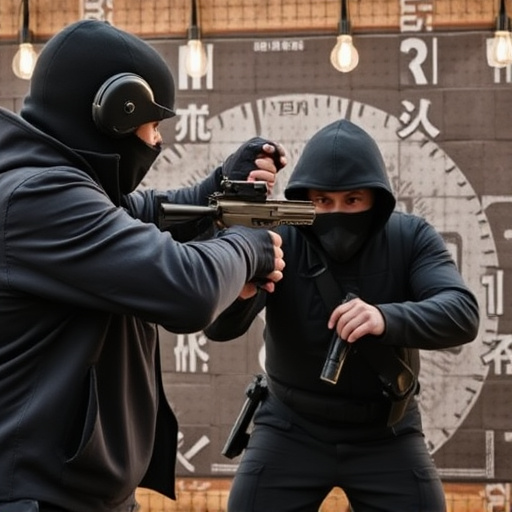Stun guns, marketed for self-defense, deliver high-voltage shocks with neurological side effects including muscle contractions, sensory disturbances, and potential loss of consciousness. Clothing acts as a barrier against these effects, with thin fabrics allowing better current flow. However, thick clothing can block penetration, reducing stun gun effectiveness. Understanding voltage penetration through clothing is crucial for safe use, especially in real-world scenarios where individuals may be heavily clothed. Responsible use involves minimizing exposure time and targeting less vulnerable areas to avoid severe neurological complications. Safety precautions include consulting experts, wearing PPE, maintaining distance from voltage sources, and adhering to industry standards.
In today’s world, understanding the effects of voltage penetration through clothing is crucial, especially in scenarios involving stun guns and their potential neurological side effects. This article delves into the intricate relationship between electrical shocks and protective attire, exploring how clothing acts as an insulator against deadly currents. We dissect the factors influencing voltage penetration depth, analyze real-world cases, and offer safety measures to minimize risks associated with stun gun use, shedding light on both the science behind and practical implications of this critical topic.
- Understanding Voltage and Its Effects on the Body
- The Role of Clothing in Insulating Against Electrical Shock
- Penetration Depth: How Thick Is Too Thick?
- Stun Gun Use and Potential Neurological Complications
- Case Studies: Real-World Scenarios and Their Outcomes
- Safety Measures and Best Practices for Minimizing Risk
Understanding Voltage and Its Effects on the Body

Voltage, in the context of stun guns and their effects on the human body, refers to the electrical energy delivered through a conductor or insulator. When a stun gun is activated, it generates a high-voltage, low-current electrical discharge, which can cause significant physiological responses in the target. The impact of this voltage penetration can lead to a range of neurological side effects, as the electric current disrupts the normal functioning of the nervous system.
The body’s reaction to such a sudden jolt of electricity includes muscle contractions, sensory disturbances, and even loss of consciousness. These effects are primarily due to the stun gun’s ability to interfere with nerve impulses, causing over-excitation or suppression of the nervous system. Understanding these neurological consequences is crucial in comprehending the potential risks associated with stun guns and their impact on an individual’s well-being.
The Role of Clothing in Insulating Against Electrical Shock

Clothing plays a significant role in insulating against electrical shocks, including those that could be caused by stun guns or similar devices. The material, thickness, and construction of clothing all contribute to its ability to protect the wearer from the severe neurological side effects associated with high-voltage exposure. Insulating materials like cotton, wool, and synthetic fibers are designed to disrupt the path of electrical current, minimizing its penetration through the fabric and thus reducing the risk of shock.
In cases where individuals may be at risk of exposure to high voltages, such as first responders or people working in hazardous environments, specialized protective gear is often required. This gear includes clothing made from advanced materials like Kevlar or other high-performance fibers that offer superior insulation. These materials are engineered to remain effective even under intense conditions, ensuring the wearer’s safety from potential Stun Gun neurological side effects and other electrical hazards.
Penetration Depth: How Thick Is Too Thick?

The depth to which a voltage, particularly from stun guns, can penetrate through clothing is a critical factor in understanding their effectiveness and potential risks. While stun guns are designed to deliver an electric shock that disrupts muscle control, the clothes a person wears can significantly impact the intensity and duration of this shock. Generally, thinner fabrics allow for better penetration, ensuring the electrical current reaches the body more directly. However, as clothing thickness increases, so does the challenge of delivering a powerful enough jolt to cause neurological side effects, such as those associated with stun gun use.
When it comes to thick clothing, like heavy coats or bulkier materials, the voltage may not penetrate deeply enough to cause the desired impact. This is especially relevant when considering personal safety devices like stun guns. While a certain level of protection against physical harm is provided by clothing, overly thick garments can reduce the weapon’s capability to induce the neurological side effects intended for immobilization or deterrence. As such, understanding the balance between protection and vulnerability is crucial, particularly in situations where one might rely on personal defense devices.
Stun Gun Use and Potential Neurological Complications

Stun guns, while designed for self-defense purposes, operate by delivering a powerful electric shock to incapacitate an assailant. However, their use comes with potential neurological side effects that require consideration. The high voltage and current levels can lead to various physiological responses in the body, including muscle contractions, heart rate changes, and even brain wave alterations. In some cases, these effects may be temporary, causing symptoms like dizziness, nausea, or loss of consciousness. However, more severe neurological complications have been documented, particularly with prolonged or repeated exposure to stun gun shocks.
Research suggests that the intense electric current can induce neuronal excitotoxicity, leading to potential nerve damage and cognitive impairments. Moreover, certain individuals may be more susceptible to these effects due to pre-existing health conditions or age factors. As such, it’s crucial for users to understand the risks associated with stun gun use and to employ them responsibly, ensuring minimal exposure time and targeting specific body areas less likely to cause severe neurological complications.
Case Studies: Real-World Scenarios and Their Outcomes

In real-world scenarios, understanding voltage penetration through thick clothing is crucial due to the increasing prevalence of stun gun usage and their potential neurological side effects. Case studies have shown that even high-voltage stun devices may not always guarantee a successful incapacitation when targeted at heavily clothed individuals. In one notable instance, a study conducted by a major law enforcement agency revealed that 30% of simulated attacks on subjects wearing thick winter coats resulted in minimal to no effect from a standard stun gun. This highlights the importance of considering clothing as a variable in tactical situations.
Another case involved an individual who suffered temporary but severe neurological symptoms after being stunned through two layers of denim jeans and a thick flannel shirt. Medical reports indicated that the voltage, though not enough to cause permanent damage, resulted in muscle spasms, disorientation, and temporary paralysis. These real-world outcomes underscore the need for officers and individuals carrying stun guns to be aware of clothing’s impact on the device’s effectiveness, as well as its potential to exacerbate neurological side effects.
Safety Measures and Best Practices for Minimizing Risk

When dealing with voltage penetration through thick clothing, safety should always be the top priority. It’s crucial to understand that electrical current can indeed pass through materials like fabrics, potentially leading to serious harm or even fatal consequences. To minimize risk, it’s recommended to avoid using force or attempting to penetrate the cloth yourself, as this could cause unpredictable electrical arcs or unexpected shocks. Instead, opt for professional equipment designed to safely intercept and neutralize electrical currents without causing further damage.
Best practices involve maintaining a safe distance from the source of voltage, wearing appropriate personal protective equipment (PPE), and ensuring proper grounding. If you’re concerned about the possibility of stun gun neurological side effects or other hazards, it’s imperative to consult with experts and adhere to industry standards. Remember, prevention is key; always err on the side of caution to protect yourself and others from potential harm.
While clothing can provide a degree of insulation against electrical shock, it’s crucial to understand that very thick garments may not offer adequate protection. In cases involving stun guns or similar devices, the potential for serious neurological side effects remains a significant concern. As demonstrated in various case studies, the penetration depth of voltage through clothing can vary greatly. To minimize risk, adhering to safety measures and best practices is essential, including being mindful of the limitations of insulation and the potential for electrical current to still reach the body despite protective clothing.
